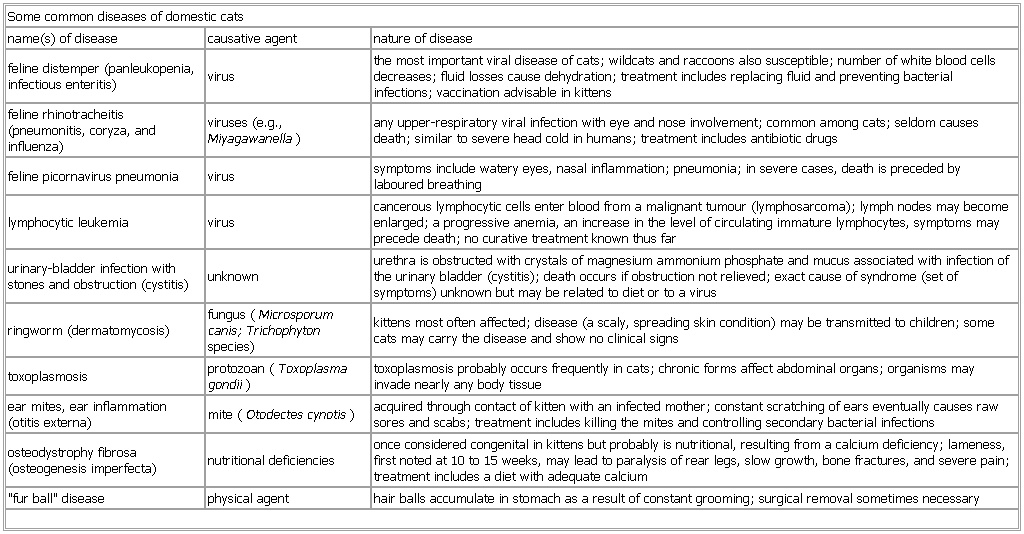- Some common diseases of domestic cats
-
▪ TableSome common diseases of domestic catsname(s) of disease causative agent nature of diseasefeline distemper (panleukopenia, infectious enteritis) virus the most important viral disease of cats; wildcats and raccoons also susceptible; number of white blood cells decreases; fluid losses cause dehydration; treatment includes replacing fluid and preventing bacterial infections; vaccination advisable in kittensfeline rhinotracheitis (pneumonitis, coryza, and influenza) viruses (e.g., Miyagawanella) any upper-respiratory viral infection with eye and nose involvement; common among cats; seldom causes death; similar to severe head cold in humans; treatment includes antibiotic drugsfeline picornavirus pneumonia virus symptoms include watery eyes, nasal inflammation; pneumonia; in severe cases, death is preceded by laboured breathinglymphocytic leukemia virus cancerous lymphocytic cells enter blood from a malignant tumour (lymphosarcoma); lymph nodes may become enlarged; a progressive anemia, an increase in the level of circulating immature lymphocytes, symptoms may precede death; no curative treatment known thus farurinary-bladder infection with stones and obstruction (cystitis) unknown urethra is obstructed with crystals of magnesium ammonium phosphate and mucus associated with infection of the urinary bladder (cystitis); death occurs if obstruction not relieved; exact cause of syndrome (set of symptoms) unknown but may be related to diet or to a virusringworm (dermatomycosis) fungus (Microsporum canis; Trichophyton species) kittens most often affected; disease (a scaly, spreading skin condition) may be transmitted to children; some cats may carry the disease and show no clinical signstoxoplasmosis protozoan (Toxoplasma gondii) toxoplasmosis probably occurs frequently in cats; chronic forms affect abdominal organs; organisms may invade nearly any body tissueear mites, ear inflammation (otitis externa) mite (Otodectes cynotis) acquired through contact of kitten with an infected mother; constant scratching of ears eventually causes raw sores and scabs; treatment includes killing the mites and controlling secondary bacterial infectionsosteodystrophy fibrosa (osteogenesis imperfecta) nutritional deficiencies once considered congenital in kittens but probably is nutritional, resulting from a calcium deficiency; lameness, first noted at 10 to 15 weeks, may lead to paralysis of rear legs, slow growth, bone fractures, and severe pain; treatment includes a diet with adequate calcium"fur ball" disease physical agent hair balls accumulate in stomach as a result of constant grooming; surgical removal sometimes necessarySee as table:

* * *
Universalium. 2010.
